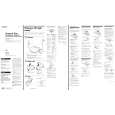|
|
|
Who's Online
There currently are 6029 guests online. |
|
Categories
|
|
Information
|
|
Featured Product
|
|
|
 |
|
|
There are currently no product reviews.
 ;
I'd been looking for this manual for awhile. Exactly what I needed - and at an excellant price. Thanks!
 ;
very complete. acceptable resolution. details are a little unclear. is a manual note 8.
 ;
excellent service - fast purchase - easy download - will buy from again
 ;
Manual is actually a pack of schematics, good quality pictures.
 ;
Great service. Manual delivered at a great price. Reliable delivery service. They have a great selection. A recommended service!
D-E707/E775
Focus/Tracking Gain Adjustment A servo analayzer is necessary in order to perform this adjustment exactly. However, this gain has a margin, so even if it is slightly off, there is no problem. Therefore, do not perform this adjustment. Focus/tracking gain determines the optical pick-up follow-up relative to mechanical noise and mechanical shock when the 2-axis device operates. However, as these reciprocate, the adjustment is at the point where both are satisfied. � When gain is rased, the noise when 2-axis device operates increase. � When gain is lowered, it is more susceptible to mechanical shock and skipping occurs more easily. This adjustment has to be performed upon replacing any of the following parts. � Optical pick-up � RV503 (Focus gain VR) � RV502 (Tracking gain VR) Normally, be sure not to move RV503 (focus gain VR) and RV502 (tracking gain VR). Adjustment procedure: � Focus Gain Adjustment � This adjustment is not performed. If focus gain VR RV503 is turned, set to mechanical center. Adjustment Location: MAIN Board (SUFFIX-11: See page12, SUFFIX-12: See page 13) � Tracking Gain Adjustment � (perform at normal operation)
The waveforms are those measured with the oscilloscope set as shown below. � VOLT/DIV: 500 mV � TIME/DIV: 5 ms � Waveform when tracking gain is lowered. Fundamental wave appears. (large waves)
��� 0 V
Adjustment and Checking Location: � MAIN BOARD (Side A) � (SUFFIX-11) � MAIN BOARD (Side A) � (SUFFIX-12)
Fig. 1
� Waveform when fundamental wave disappears. (no large waves)
��� 0 V
Fig. 2
� Waveform with no traverse waveform during 100 track jump. (Brake application is smooth because of adjustment)
��� 0 V
TP522 (RFO)
100 track jump waveform
oscilloscope (DC range)
TP401 (VCC)
TP522 (RFO) TP401 (VCC) RV401 (VCC) RV401 (VCC)
Fig. 3
� Waveform with traverse waveform during 100 track jump. (Brake application is poor because of adjustment)
MAIN board TP (TE) TP520 (VC) SUFFIX-11: See page 12 SUFFIX-12: See page 13 10 k �
+ �
0.0022 µF
��� 0 V
1. Place the optical pick-up level, horizontally. (If the optical pick-up is not level, the 2-axis device will be weighted and adjustment cannot be done) 2. Connect the oscilloscope to TP (TE) and TP520 (VC) on the MAIN board. 3. Set the disc (YEDS-18) and press the ^ key. 4. Turn RV502 slightly clockwise (tracking gain drops) and obtain a waveform with a fundamental wave (waveform has large waves) as in Figure 1. 5. Turn RV502 slowly counterclockwise (tracking gain rises) until the fundamental wave disappears (no large waves) as in Figure 2. 6. Set RV502 to the position about 30� counterclockwise form the position obtained in step 5. If RV502 contact point is more than 90� counterclockwise from mechanical center, tracking gain is too high. In this case, readjust from step 4. 7. Press + or = key and observe the 100 track jump waveform. Check that no traverse waveform appears for both + or = directions. (See Figures 3 and 4) It is acceptable if the traverse waveform appears only now and then, but if it appears constantly, raise tracking gain slightly and check step 7 again. 8. Check that there is not abnormal amount of operation noise (white noise) from the 2-axis device. If there is, tracking gain is too high, readjust starting with step 4.
100 track jump waveform traverse waveform
Fig. 4
Adjustment Location: MAIN Board (SUFFIX-11: See page12, SUFFIX-12: See page 13)
RV503 Focus Gain Adjustment
TP520 (VC)
TP (TE)
RV502 Tracking Gain Adjustment
RV503 Focus Gain Adjustment
TP520 (VC)
TP (TE)
RV502 Tracking Gain Adjustment
� 11 �
� 12 �
� 13 �
 $4.99 D-E707 SONY
Owner's Manual Complete owner's manual in digital format. The manual will be available for download as PDF file aft…
|
|
 |
> |
|
